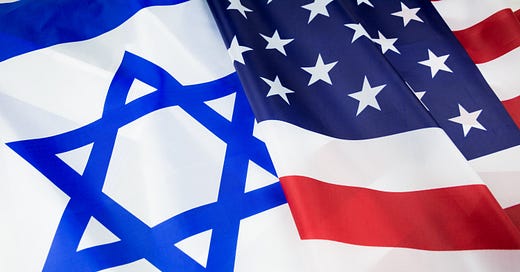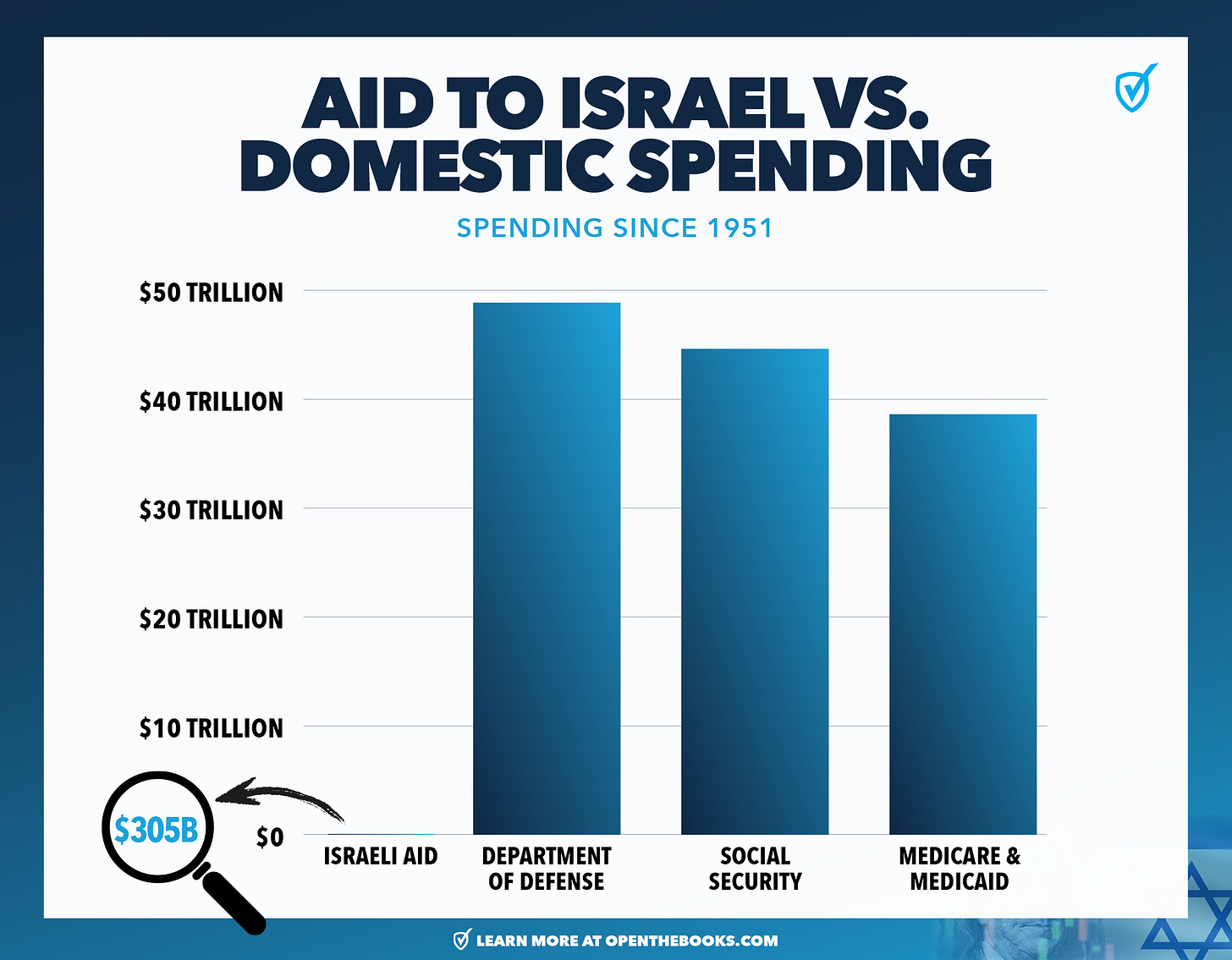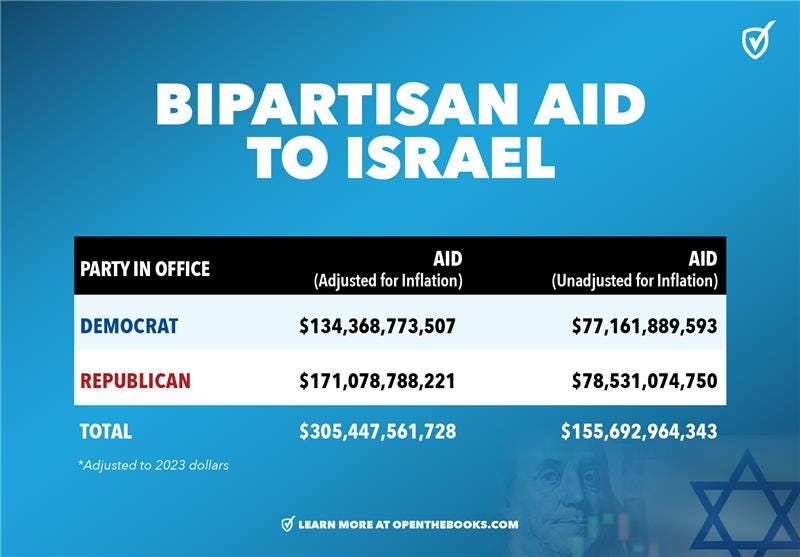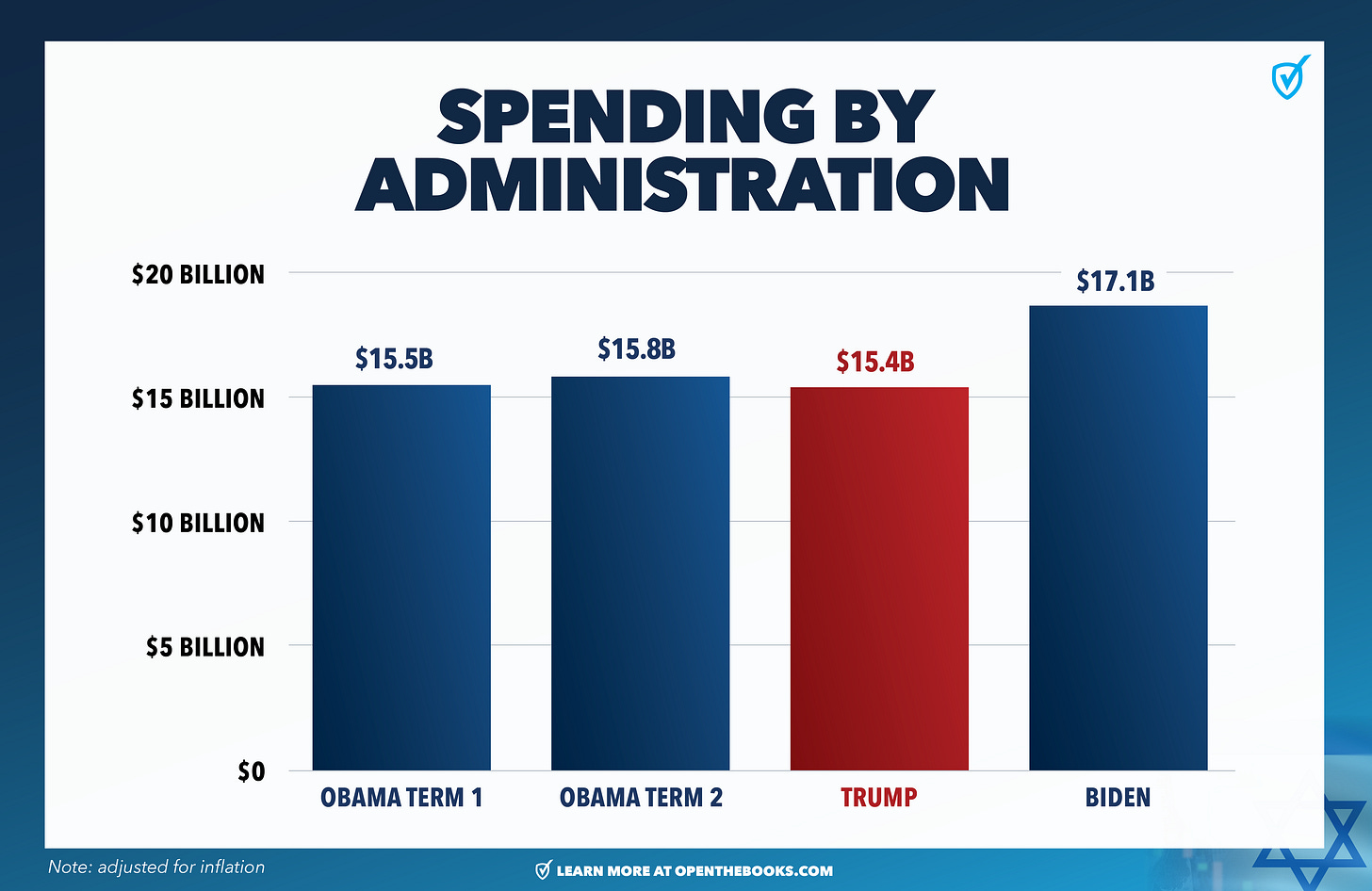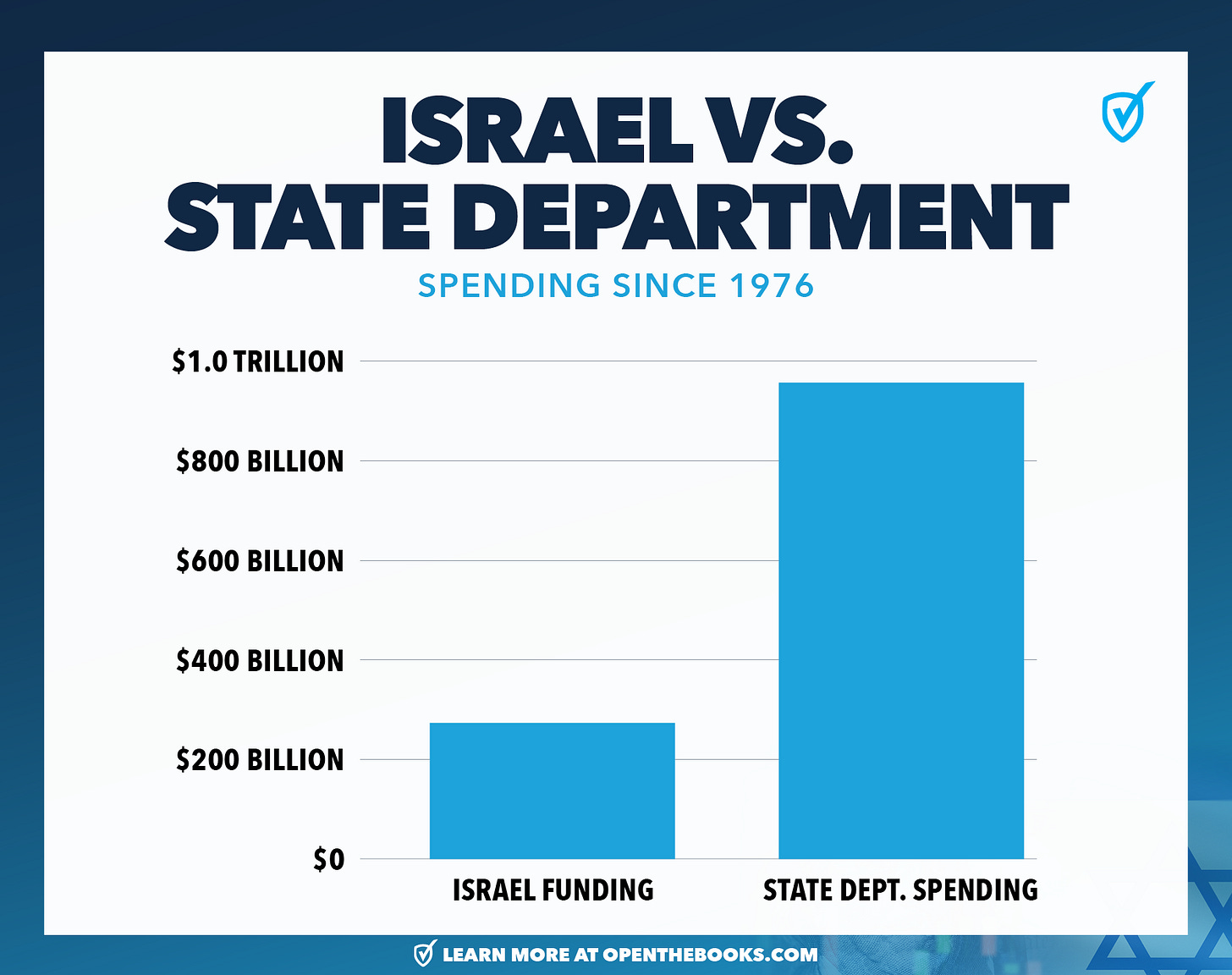Support for Israel has a Long Bipartisan History
Israel has enjoyed generous support from the United States for nearly 75 years. Since 1951, Americans have given $305.4 billion in foreign aid to Israel, adjusted for inflation ($155.6 billion not adjusted for inflation). Aid has averaged around $4 billion a year since 2004.
But unlike what some critics would have us believe, our aid to Israel has been a miniscule amount of our outlays to our own defense and other domestic priorities. Since 1951, while the U.S. has spent $305 billion on Israeli aid, $218 billion of that for military and defense, we've spent $47 trillion through our own Department of Defense. In the same timeframe, the U.S. spent $42 trillion on its Social Security program, and $37 trillion between Medicare and Medicaid. (Figures are adjusted for inflation).
Aid to Israel therefore would be 0.6% of the DoD spending, and 0.3% of entitlement spending.
Similarly, American defense spending is a fraction of Israeli defense spending. In 2023, for example, Israel spent $27 billion on its military, according to data from SIPRI. American aid to Israel that year was about $3.3 billion, or around 12% of the total.
Most aid to Israel since 1951 is related directly to military and defensive spending—about $218.6 billion. Over 99 percent of military and defensive aid is not a “hand out” or a “blank check” but aid that enables and requires Israel to purchase advanced American military equipment, like 50 F-35 fighter jets and four KC-46a refueling planes, made in the United States.
Moreover, this aid, like all aid, has to be assessed in the context of the fungibility principle. For instance, even though Mossad – the Israeli intelligence service – carried out the “beeper operation” against Hezbollah, American taxpayers indirectly supported that operation by freeing up Israeli resources and lowering procurements costs of other military hardware and equipment.
Over the decades, Republican administrations have given about 27% more in aid than Democrats, $171 million (R) compared to $134 million (D), but support has been consistently bipartisan as the White House has changed hands.
The Reagan administration delivered the most aid ($55 billion), followed by the Clinton ($45 billion), Carter ($35 billion), and Obama ($31 billion) administrations. In terms of single, four-year terms, the Carter administration gave the most aid, followed by Reagan’s second administration ($30 billion) and the H.W. Bush administration ($26 billion).
Republican administrations have given about $37 billion more in aid to Israel than Democratic administrations, although from 1951, when aid started, to 2024, Republicans have been in power for 40 years and Democrats have been in power for 34.
Year for year, Republicans average $4.2 billion while Democrats average $3.9 billion.
Nearly all the top 20 years for most aid to Israel occurred in the 1970s and 1980s, with two exceptions: 2000, with $6.5 billion, and 2024, with $6.8 billion.
The year with the most aid was 1979, when Egypt and Israel signed a peace treaty under the Camp David Accords. The U.S. gave Israel $4.7 billion that year to withdraw from the Sinai Peninsula and ensure stability in the region; adjusted for inflation that amount is $16.4 billion.
AID TO ISRAEL BY THE NUMBERS
The following is a look through foreign assistance provided to Israel since records started in 1951. All numbers are adjusted for inflation unless stated otherwise.
Note on Methodology and Data
Israeli aid spending data was taken from ForeignAssistance.gov. This dataset adjusted inflation to 2023. For broader government spending trends we used data taken from the Office of Management and Budget, adjusted for inflation to 2023 with the Congressional Budget Office inflation tool.
Military and Nonproliferation Aid
About 72% of total U.S. aid to Israel, or $221.9 billion, has gone to aid Israeli defense. Nearly all, $216.6 billion, was spent through the Department of State’s Foreign Military Financing program.
Additionally, the Department of Defense has spent $5.2 billion, and the Department of Energy provided $33.5 million in funds related to regional nuclear disarmament and nuclear threat detection.
Department of State
Most American foreign assistance to Israel goes through the Department of State’s Foreign Military Financing (FMF) program at $216.6 billion, adjusted for inflation ($199 billion unadjusted).
FMF was formally established under the 1976 Arms Export Control Act to give friendly foreign governments funds to purchase American weapons and defensive technologies. Similar programs existed before that legislation was passed, however, and are included in these spending totals.
FMF has accounted for over 95% of funding to Israel since 1976, and at least 98% since 2001.
A 10-year Memorandum of Understanding between the U.S. and Israel states that the U.S. will provide $3.3 billion in FMF and $500 million in cooperative programs for missile defense (like the Iron Dome) from 2019-2028.
The U.S. kept those commitments until 2024, when aid more than doubled to $6.8 billion in the aftermath of the Hamas attack on Israel in October 2023.
Since 2019, Israel made up a little more than half of FMF funding:
Total Department of State spending, FMF budget and Israel FMF spending, 2019-2023, not adjusted for inflation.
Other top recipients of FMF funds (using FY 2023 as an example) include:
Egypt: $1.8 billion
Jordan: $425 million
Iraq: $250 million
Other countries include:
Vietnam: $12 million
Costa Rica: $7.5 million
Djibouti: $6 million
In 2022, Ukraine and surrounding countries received $4.6 billion in FMF funding through supplemental appropriations, of that Ukraine itself received $1.317 billion.
State Department Pt. II: Non-Defense Spending
The second largest (although comparatively much smaller) Department of State funding activity to Israel is the Humanitarian Migrants to Israel program, which works to settle Jewish migrants in the former Soviet Union and other countries, like Ethiopia, in Israel.
Records indicate $530 million has been spent on this program since 2003, adjusted for inflation ($380 million unadjusted). The highest yearly spending amounts occurred during the W. Bush administration—spending reached as high as $94 million in 2003, adjusted for inflation ($60 million unadjusted).
In 2023, the last year with recorded spending in this category, funding was $1.05 million.
Put in context, all of these State Department line items are just a small chunk of what we spend on diplomacy, foreign aid, and the whole Foggy Bottom hierarchy:
Department of Defense
The DoD has sent $5.2 billion to Israel, adjusted for inflation, since 1976.
Most of this funding, $3.1 billion, came from a program labeled “other military grants” in 1976 (worth $412 million today) and 1979 (worth $2.7 billion today).
The second biggest spending category is for the Excess Defense Articles program, which spent $1 billion since 1993. This DoD program allows the DoD to transfer materials it no longer needs to foreign partners at low to no cost.
Examples from 2023 include:
$1,581,765 for 52 cargo trucks
$895,392 for 27,674 flyers’ gloves
$80,035 for 3,502 sleeping bags
The Military Assistance Program spent $871.3 million, adjusted for inflation between 1990 and 1994. The program's functions—helping friendly nations purchase American defensive technology—have largely been replaced by FMF.
Department of Energy
During the Obama and Biden administrations, the U.S. Department of Energy gave $33.5 million in foreign assistance to Israel, largely for nuclear nonproliferation projects. Most such funding, $27.5 million from 2009-2014, went through DOE’s Second Line of Defense program, which works to prevent passage of nuclear materials through border crossings, seaports, and airports.
Miscellaneous Spending
Since 1951, over $82 billion was spent by agencies other than those listed previously—agencies not involved in military and defense.
The biggest funder of foreign assistance to Israel in this category is the U.S. Agency for International Development (USAID), which spent $77.3 billion.
USAID spent on an array of projects, although most funding fell under the general category “USAID Grants,” worth $61.8 billion from 1952-1998, inflation adjusted.
The “Support Policy Reform for Financial Stability,” which were cash transfers to Israel from 2001-2006 intended to improve its economy and stabilize the region. These were worth $5.1 billion adjusted for inflation.
Other projects include agricultural research $103,410 for “improving olive oil quality in Middle Eastern countries in close cooperation with Israeli, Jordanian and Egyptian partners” and $124,635 for developing a “holistic approach for plant nutrition by utilization of organic waste.”
The U.S. Department of Agriculture itself also has supported Israel with $4.697 billion in funding, primarily though programs created by the Agricultural Trade Development and Assistance Act of 1954, also known as Food for Peace.
These programs granted or loaned money to Israel and other countries to purchase American agricultural products or gave food aid directly. From 1952-1980, over $4.692 billion was given to Israel under this program, adjusted for inflation.
More recently, the U.S. Forest Service, a subagency of USDA, spent $3.6 million on Israeli forest management from 2005-2010. In 2020, USDA gave $37,500 to the Israeli city of Haifa for “urban renewal and resilient landscapes” and in 2022 gave $1.15 million to support “agricultural research and development activities of mutual benefit to the United States and Israel.”
Social Justice Spending
Israel was not spared the influence of radical left-wing ideology permeating American grant making under the banner of so-called social justice and diversity, equity, and inclusion, although it represents a small fraction of total aid.
Some examples include:
$193,921 from the Department of State in 2024 to “advance DEI reforms in 30 participating high-tech companies” in Israel, “support inclusive economic growth of Arab women in the Israeli high-tech sector,” and “ensure employment reforms created by DEI integration of 50 Arab women in Israeli high-tech companies.”
$248,977 from the Department of State across two grants in 2015 and 2016 to “advance gender equality and women economic, political, and social inclusion in Israel.”
$125,115 from the Department of State in 2015 to provide 150 Arab and Jewish high school girls with a “platform for working together on issues of common concern”
$139,442 from the Department of State in 2019 for the Kayan Feminist Organization, which “consolidat[es] an active, systematic, nationwide Arab Palestinian feminist movement that actively affects social change.”
CONCLUSION
While aid to Israel hasn’t been immune to the waste, fraud and abuse that has infiltrated all corners of government, the vast majority of the spending has aided in building Israel’s strategic defense capacity and much of it has been spent on equipment purchases that accrue back to America’s economic benefit.
Whatever happens next, Open the Books will continue providing raw numbers so taxpayers can draw their own conclusions.
RELATED READING
America is Deeply Invested in Israel’s Success | Open the Books | Substack | 18 June 2025
Aid for Ayatollahs: Financial Benefits to Iran Facilitated by Uncle Sam | Open the Books | Substack | 17 April 2025
Agency Capture – Biden Allocated $1.2 Billion To The United Nations Relief And Works Agency (UNRWA) | Open the Books | Substack | 1 February 2024


